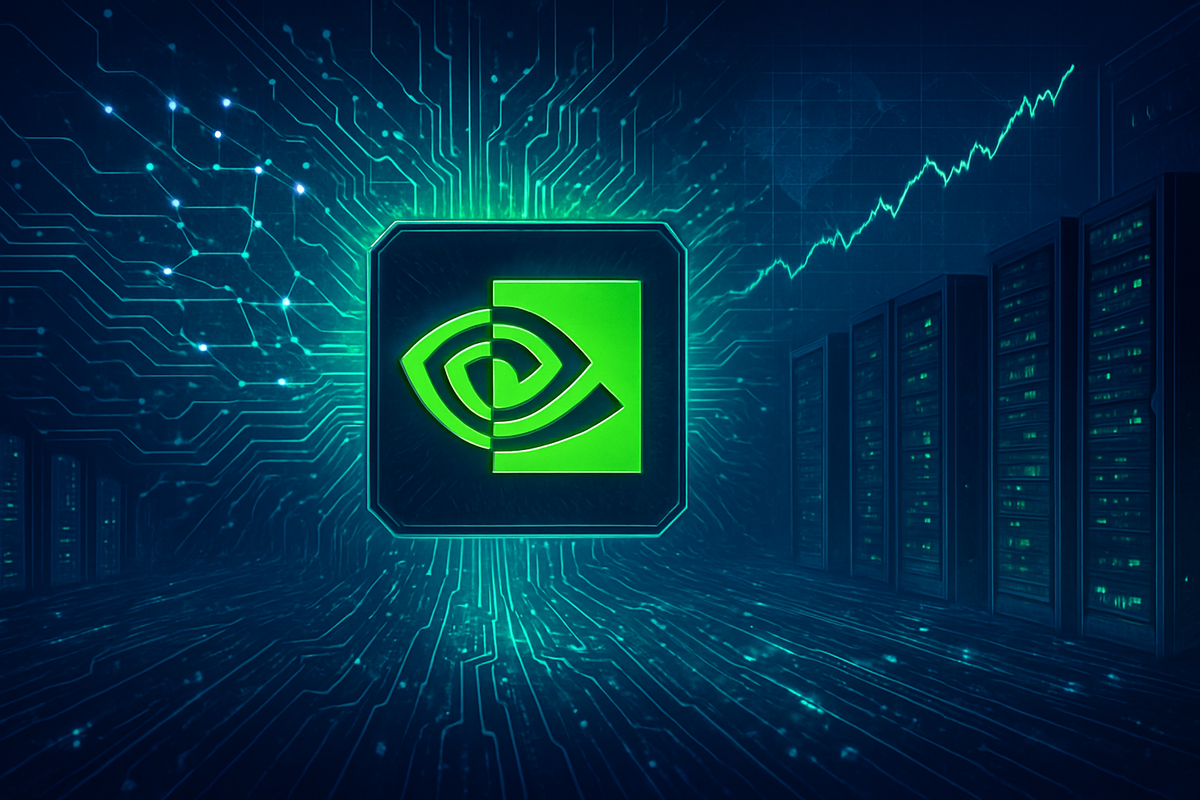
NVIDIA (NASDAQ: NVDA) has firmly cemented its position as a financial market powerhouse, achieving an unprecedented $5 trillion market capitalization, a first for any company globally. This monumental milestone, reached as of October 30, 2025, underscores the semiconductor giant's extraordinary growth and its pivotal role in shaping the future of technology. With a staggering 52.15% increase in its market cap over the past year, NVIDIA stands out as a "Promising Large Cap Stock," attracting significant investor attention through its relentless innovation and market dominance across critical sectors.
The company's meteoric rise is largely attributed to its indispensable contributions to the artificial intelligence (AI) revolution, its overwhelming leadership in the data center market, and its sustained strength in gaming. Investors are drawn to NVIDIA's robust financial performance, strategic expansions, and its ability to consistently exceed market expectations, making it a compelling investment in an increasingly tech-driven global economy.
Unpacking NVIDIA's Unprecedented Ascent and Market Dominance
NVIDIA's journey to a $5 trillion valuation has been marked by a series of exceptional financial performances, consistently outperforming analyst projections across fiscal years 2024, 2025, and into the current fiscal year 2026. The company's data center segment has been the primary engine of this growth, fueled by insatiable demand for its cutting-edge GPUs essential for training and deploying complex AI models.
Throughout fiscal year 2024, NVIDIA reported record-breaking revenues, with Q3 FY24 seeing $18.12 billion (up 206% year-over-year) and Q4 FY24 reaching $22.1 billion (up 265% year-over-year). This momentum carried into fiscal year 2025, with Q1 FY25 hitting $26.0 billion in revenue (up 262% year-over-year) and Q3 FY25 closing at $35.1 billion (up 94% year-over-year). The current fiscal year, 2026, continues this trend, with Q1 FY26 revenue at $44.1 billion and Q2 FY26 at $46.7 billion, demonstrating sustained, aggressive growth. The company's data center revenue alone has seen astronomical increases, reaching $41.1 billion in Q2 FY26. This consistent outperformance, coupled with significant stock buybacks, such as the $11 billion in Q3 FY25, highlights NVIDIA's strong financial health and commitment to shareholder value.
NVIDIA's dominance is not merely financial; it is deeply rooted in its technological leadership. The company commands over 80% of the market for GPUs used in AI training and deployment and an overwhelming 90% market share in the data center GPU segment. Its proprietary CUDA software platform and extensive libraries create a formidable ecosystem, locking in developers and reinforcing its competitive moat. Key players benefiting from NVIDIA's technology include major cloud-service providers like Amazon (NASDAQ: AMZN), Google (NASDAQ: GOOGL), and Microsoft (NASDAQ: MSFT), as well as countless enterprises and research institutions relying on NVIDIA's hardware for their AI initiatives. The market has reacted with resounding confidence, reflected in a consensus "Strong Buy" rating from analysts, with price targets forecasting continued upside.
The Ripple Effect: Winners, Losers, and Strategic Shifts
NVIDIA's unparalleled success has profound implications, creating significant winners and losers across the technology landscape and forcing strategic shifts among competitors and partners alike. The most obvious winner is NVIDIA itself, which continues to consolidate its lead in the burgeoning AI and data center markets. Its strong financial position allows for aggressive investments in R&D, strategic acquisitions (like Mellanox Technologies Ltd.), and expansion into new verticals such as AI processing as a service, robotics, and autonomous vehicles.
For companies heavily reliant on AI infrastructure, such as cloud service providers and AI startups, NVIDIA's advanced GPUs are indispensable. While this ensures cutting-edge performance, it also creates a dependency, potentially increasing their operational costs and limiting their bargaining power. These "hyperscalers" are increasingly investing in developing their own AI chips (e.g., Amazon's Inferentia, Google's TPUs), seeking to reduce reliance on NVIDIA and gain greater control over their hardware stack. This strategic pivot represents both a challenge and an opportunity for NVIDIA, pushing it to innovate faster and offer more comprehensive solutions.
Competitors like Advanced Micro Devices (NASDAQ: AMD) and Intel (NASDAQ: INTC) are the most direct "losers" in terms of market share, as they struggle to catch up with NVIDIA's technological lead in AI GPUs. While AMD has made strides with its Instinct MI series, and Intel is pushing its Gaudi accelerators, NVIDIA's established ecosystem, performance benchmarks, and sheer scale present formidable barriers to entry. However, the immense demand for AI hardware means there's still a growing market for all players, albeit with NVIDIA taking the lion's share. In the gaming sector, NVIDIA's sustained dominance with its RTX 50 series graphics cards ensures its continued revenue stream, while also pushing competitors to innovate in graphics technology and AI-powered gaming experiences.
Broader Significance: AI's Infrastructure and Geopolitical Undercurrents
NVIDIA's ascendancy is not an isolated event but a clear indicator of broader industry trends, particularly the accelerating global investment in artificial intelligence. The demand for powerful computing infrastructure to train and deploy complex AI models is skyrocketing, making NVIDIA's GPUs the foundational technology for this revolution. This event underscores the critical importance of specialized hardware in driving technological progress, echoing historical shifts where core components became bottlenecks or enablers for new eras of computing.
The ripple effects extend far beyond direct competitors. Partners in the server manufacturing, networking, and software development industries are directly impacted, with those integrated into NVIDIA's ecosystem experiencing growth. The sheer scale of NVIDIA's operations and its influence on AI development also brings regulatory and policy implications. Concerns over market concentration, potential monopolistic practices, and the geopolitical implications of advanced chip technology are increasingly becoming subjects of scrutiny. The ongoing U.S.-China trade tensions, particularly regarding export restrictions on advanced chips, have already impacted NVIDIA, leading to a $4.5 billion charge in Q1 FY26 due to diminished demand for H20 products in China. However, recent discussions suggesting a potential easing of these tensions could provide a significant positive catalyst for NVIDIA to reestablish its presence in the crucial Chinese market.
Historically, dominant technology companies have faced similar challenges, from antitrust concerns to intense competition. NVIDIA's current position draws parallels to Intel's dominance in the PC era or Microsoft's in operating systems. However, the rapid pace of AI innovation and the global nature of its deployment present unique complexities. The company's strategy of not just selling chips but building entire "AI factories" and developing comprehensive software platforms like CUDA positions it as more than a hardware vendor, creating a deep integration into the AI value chain that is difficult to replicate.
The Road Ahead: Sustaining Momentum in a Dynamic Market
Looking ahead, NVIDIA faces both immense opportunities and evolving challenges. In the short term, the continued rollout of its Blackwell next-generation GPUs, designed for trillion-parameter scale AI computing, and its Blackwell-powered DGX SuperPODs, will be critical. These innovations promise significant performance improvements, further entrenching NVIDIA's technological lead. The company's expansion into AI processing as a service and its deepening partnerships, such as the $100 billion investment with OpenAI to scale AI infrastructure and building seven new supercomputers with the U.S. Department of Energy, will drive immediate growth.
Long-term possibilities include further diversification into vertical industries like healthcare, automotive (autonomous vehicles), and robotics, where AI integration is still in its nascent stages but holds immense potential. Strategic pivots will likely involve a continued focus on comprehensive platform solutions, combining hardware, software, and services, rather than just selling discrete components. Market opportunities will emerge from the ever-increasing demand for AI capabilities across all sectors, from enterprise solutions to consumer applications.
However, challenges persist. The intensifying competition from hyperscalers developing in-house chips and rival chipmakers like AMD and Intel remains a significant threat. Geopolitical factors, particularly trade relations and export controls, could still impact NVIDIA's global market access and supply chains. Furthermore, the rapid evolution of AI itself could lead to shifts in architectural preferences or new computing paradigms that might challenge NVIDIA's current dominance. Potential scenarios range from continued exponential growth, driven by sustained AI adoption, to a more moderated growth rate if competition intensifies or regulatory hurdles become more pronounced.
A $5 Trillion Benchmark: NVIDIA's Lasting Impact
NVIDIA's achievement of a $5 trillion market capitalization is a landmark event, signaling not just the company's individual success but also the profound and accelerating impact of artificial intelligence on the global economy. The key takeaway is that NVIDIA has successfully positioned itself as the indispensable infrastructure provider for the AI era, much like Microsoft (NASDAQ: MSFT) and Intel (NASDAQ: INTC) were for the PC era. Its dominance in AI chips, coupled with the strength of its CUDA software ecosystem, creates a powerful competitive moat that will be challenging for rivals to overcome in the near future.
Moving forward, the market will closely watch NVIDIA's ability to maintain its innovation pace with new architectures like Blackwell, its strategic expansion into new AI-driven verticals, and its navigation of complex geopolitical landscapes. Investors should pay attention to quarterly earnings reports, product announcements, and any shifts in the competitive dynamics of the AI chip market. The long-term significance of NVIDIA's rise is that it highlights the immense value creation possible at the intersection of advanced hardware and transformative software, setting a new benchmark for what a technology company can achieve in the 21st century.
This content is intended for informational purposes only and is not financial advice






